The June 2011 monthly unemployment figures show the official unemployment rate increased to 9.2% and the total jobs gained were 18,000. Total private jobs came in at 57,000 with government jobs dropping -39,000. Since March the official unemployed has increased by over half a million.
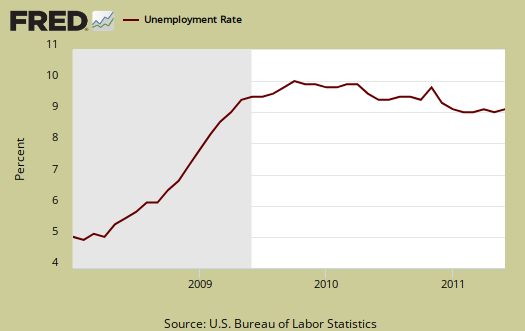
Those entering not in the labor force increased by 449,000. The labor force participation rate dropped -0.1% to 64.1%, worse, not rounded, 64.06%. This is the lowest labor participation rate since March 1984!.
Those civilian labor force dropped -272,000 while the noncivilian population increased by +176,000. What this means is even more people dropped out of the count for June and are not tallied into the unemployment rates. U6, or the broader unemployment measurement, increased 0.4% to 16.2%. By every indicator we can gleam from the monthly numbers the situation is horrific, with people dropping out and those still counted increasing dramatically.
Below is the nonfarm payroll, the total number of jobs, seasonally adjusted. Since the start of the great recession, declared by the NBER to be December 2007, the United States has officially lost 6.97 million jobs. That does not take into account additional jobs needed to employ the United States increased population, but does include the jobs added over the over 3 and a half years, or 42 month time period.
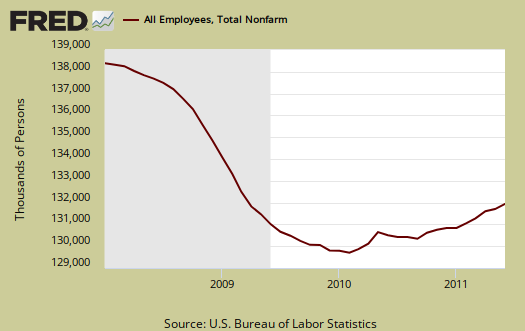
Below is a running tally of how many official jobs permanently lost since the official start of this past recession (recall the private NBER has declared the recession over!). This is a horrific tally and notice this isn't taking into account increased population growth, which implies the United States needs to create at least 10.83 million jobs or self-employment. This estimate assume a 62.7% civilian non-institutional population to employment ratio, as it was in December 2007, which implies an additional 3.86 million jobs needed over a 3.42 month time period.
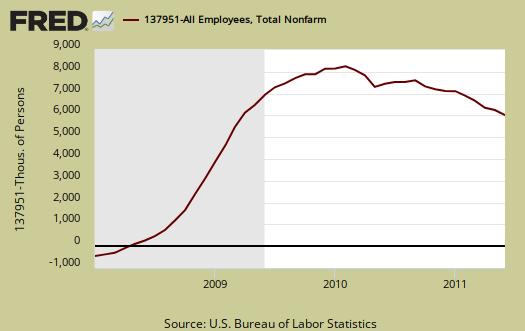
A graph of the alternative unemployment measurement, U-6, is posted below. Here you can see the incredible increase in comparison to the beginning of this broader unemployment measurement as well as the new uptick in the rate.
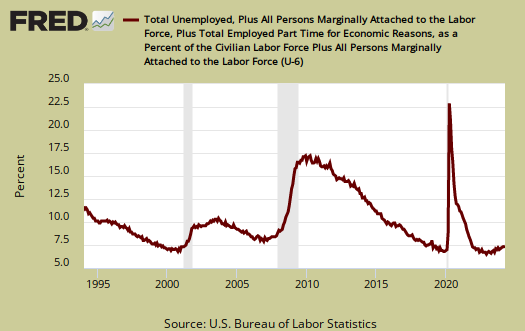
How can the unemployment rate increase? The official unemployed increased by 173,000, alternatively the employed decreased -445,000. The actual labor force dropped by -272,000. The employment to population ratio dropped -0.2% to 58.2%. So, in spite of 272,000 dropping out of the count of the labor force, the 445,000 drop in employed people increased the official unemployment rate by ratios.
You may notice these numbers exceed the actual number of jobs created, 18,000, by the BLS. The BLS has two different surveys, two different methods, and additionally is counting other types of work beyond payroll. These numbers are from the household survey whereas the actual job count is from the establishment survey.
Below is an annualized graph of civilian institutional population. It's from this superset of people that potential workers come from.
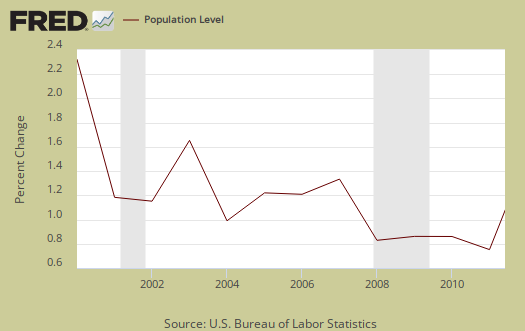
The civilian labor force decreased by -272,000, while the civilian population increased by +176,000. Yet those not in the labor force increased by +449,000. This means a lot more people dropped out of the count.
The civilian non-institutional population are those 16 years or older not locked up somewhere or not in the military or so sick and disabled they are in a nursing home and so on.
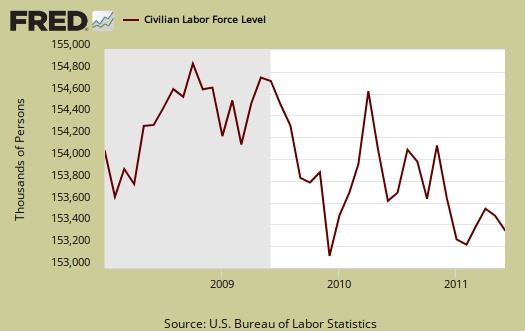
The increasingly low labor participation rate is now at 64.1%. If we go back to December 2007, the labor participation rate was 66%. The highest civilian labor participation rate was in January 2000, at 67.3%. What this means is there are over 4.55 million people not be accounted for in the official unemployment rate who probably need a job and can't find one and no, they are not all baby boomers retiring (many who cannot retire due to having no retirement money).

The employment to population ratio is now 58.2% which is at record lows. You have to go back to August 1983 to find such low ratios. This isn't a structural change, such as all families decided to have a stay at home caretaker, or magically a host of people could retire early, this is people dropping out of the count. They need a job, but stopped looking, fell off of the rolls, stop being counted.
These numbers are important because unemployment is a ratio, percentage or during a limited time period, the number of people actively looking for a job and counted. Many people are not counted in the official unemployment statistics, due to definitions, but obviously when one has more potential workers and less jobs, that metric doesn't bode well for America.
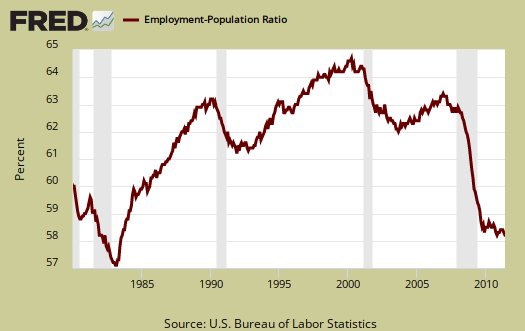
Below is the graph of the civilian non-institutional population, which is the largest super-set of the potential labor force, larger than the civilian workforce, due to those who are not looking for work, retired and so on being counted in this figure. This is why one must create jobs greater than the constant rate of jobs lost. There are more people to employ. Unemployment is a percentage, a ratio.
The BLS unemployment report counts foreign temporary guest workers as well as illegal immigrants in their U.S. labor force statistics.
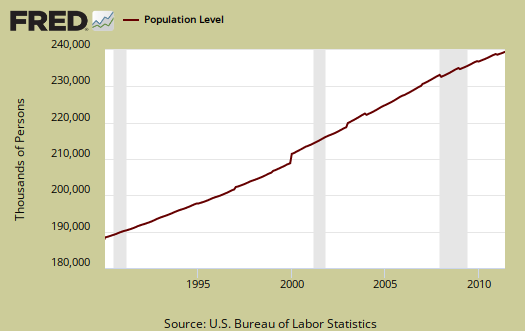
One needs at least 98,000 and some estimate up to 375,000 permanent full time jobs, added each month just to keep pace with U.S. civilian workforce population growth. That's not general population, that's the group needing a job.
This unemployment report doesn't even give enough jobs to keep up with population growth. It's so dismal maybe now, politicians will realize we have a jobs crisis going on for over 42 months!

How Much Longer Will It Go On?
At this rate, how much longer will it take for full employment?
Do you know if there are any current and publicly available official estimates on that?
Or is everybody with the data available to make the calculations afraid to run it? What assumptions would they use -- new job creation of 25,000 a month, with new labor entrants of 150,000? Would that produce the answer of never?
Conyers' full employment bill and tax on Wall Street
The concept of full employment as a sustainable expectation for America has been eroded over the decades -- since the Full Employment Act of 1946 and other full-employment legislation over the years. The idea of a full-employment policy needs to be brought out and repeated many times -- by members of Congress, by the White House, on every news channel. How can young people U.S.A. today even imagine such a policy?
Currently, Rep. John Conyers, Jr., (D-Mich.) is promoting renewal of the Humphrey-Hawkins Full Employment Act, which was enacted during the Carter Administration and codified under the Full Employment Act of 1946. Conyers, well known as Dean of the Congressional Black Caucus, was first elected to Congress in 1964 and, so, has been around long enough to recall the good old days. (Conyers' endorsement of candidate Barack Obama was a key event in Obama's successful 2008 run for the Democratic nomination and for the presidency.)
Conyers has named the bill (pending without a chance in the current House) "Humphrey-Hawkins 21st Century Full Employment & Training Act" (HR 870) It's described by Conyers as "deficit neutral" by way of being "fully funded by a tax on Wall Street speculation."
Conyers explains the idea as follows: "Wall Street was responsible for the financial crisis that began in 2008 and continues to affect us today. Having already received significant assistance from the federal government, it is only fair that Wall Street now pay Main Street back by helping put America back to work.”
Humphrey-Hawkins, like the 1946 Act, was based on a pump-priming (Keynesian) theory of economics. That's okay, as far as it goes, but the reality is that Keynesian methods cannot possibly work within the current world-system of globalized finance capitalism, without some kind of protectionism -- unless you think that the U.S. is capable of underwriting full employment for the entire planet. The word "training" in Conyers' bill probably goes back to the Clinton administration which approached unemployment as essentially a "training" problem, so that what might have been called "full employment" legislation was described in terms of the need of American workers to be retrained due to rapid changes in technology. The "retraining" projects were paid out of general funds or out of unemployment taxes and (as "free" trade agreements came into effect) by funds alloted by Congress for workers who had been "temporarily" displaced as a result of "free" trade.
IMO, a full employment policy for the U.S. must begin with a 15% Across-the-Board tariff (or VAT, if you prefer). Having said that, Conyers' legislation probably could be helpful as a short-term measure. Of course, it has the chance of the proverbial snowball in a hot place.
(Yes, I am aware that Greece's VAT, now increased, has hardly prevented the collapse of their economy. The tariff or VAT must be part of a general reform of the financial, tax and monetary system. Greece is a very interesting case, as is the entire thing about the Euro, but I don't think we should generalize it to the United States.)
Dean Baker - 90k jobs/mon for Pop growth
This is very low 90k jobs to keep up with population growth and this is one of those numbers that changes and has a host of assumptions to calculate.
I think 90k is wishful thinking frankly. I believe they are taking the current labor participation rate to come to this conclusion. I think that's crap for it leaves out the many who dropped out of the count.
It is true that non-institutional population growth seems to have decreased in slope as of recent, but the participation rate should be really at least 2007 levels to calculate the number of jobs per month.
See the graph of labor participation rate and how far it has dropped. Sorry I think that's abby normal.
If one adds up the number of people not in the labor force with the number of jobs needed to keep up with population growth, it's over 14 million.
Just do not think an artificially low labor participation rate is useful here.
I respect Dean Baker greatly, he's almost always right, but on this one, I think it's wishful thinking.
Now, if one took out the illegals and the guest workers, maybe. ;)
Why Don't You Present Your Case to Him?
This is an important point. The government doesn't use 90,000, you don't, so why does he?
Why not send him an email, tell him why you disagree and see what he says.
LOL
"Why not send him an email?"
Yeah. Right. Of course.
should have....but
I know why they came up with 90k, they used the current labor participation rate instead of the 2007 one plus did a labor force slope rate. I don't find that valid since so many have dropped out of the count.
I know Dean Baker can calculate how many jobs for himself, so why he choose to say that is beyond me. He's usually dead on.
You'll see a lot of variation on "what are the number of jobs per month to keep up with population growth" and most of them are valid. It depends on what labor participation rate one uses, the labor force growth rate or the civilian non-institutional population growth rate, the time window (as well) over what period.
I went through some of these calculations here, and show partial calculations and assumptions.
Seems I should go into way more detail and show a few methods next time.
That's the key, EPI uses slightly different numbers in their calculations. Then something no one talks about is the non-institutionalized civilian population means all of those people in jail and in the military are not in the base count.
Well, we have some of the highest prison populations to overall population ratios in the world.
We also have a lot of Vets coming out of the military who cannot find a job and it's so bad many are going homeless.
I guess I can do through this again with all of the ways to calculate out this number, but bottom line it does vary depending on what one uses.
I think Baker was more pointing to the NY Times not doing their own calculations, which is very, very common in the press.
That's another reason I go over these economic reports. I do calculate numbers straight from the data and the reports, so when it differs, either I made a math boo-boo or I have different assumptions.
US Citizens Get Raw Deal
While millions of US Citizens go unemployed the BLS counts undocumented aliens and visa program workers in our labor statistics which clouds the plight of unemployed American Citizens.
They can begin to contemplate how to help US citizens until they deport and end employment for unneeded foreign nationals displacing the American Laborforce.
It should be elementary
First, full employment ... then and only then ... work visas.
That should be, like, fundamental. Civilized nations generally have had such a policy.